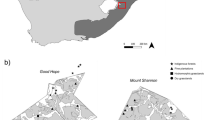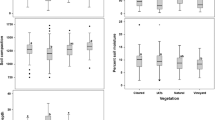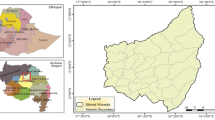Abstract
Drylands are ecosystems, where lack of rains imposes harsh conditions for the survival of organisms. These ecosystems are also susceptible to degradation and desertification. Their conservation depends on the understanding of the ecological functioning of vegetation and soil. In drylands, the vegetation is spatially structured as a mosaic of patches (vegetation) and interpatches (bare soil). This structure is a consequence of plant-plant interactions (facilitation and competition). Empirical data and modeling approaches reinforce the role of ecological facilitation for the maintenance of all organisms in drylands. However, the true range of facilitation is still poorly known. Here, we explored data of meso- and microarthropods living in soil, as bioindicators, to infer the range of facilitation provided by plants to soil. As dependent variables, we regard data of abundances and species richness collected in random patches (independent samples) and bare soil places. Data from patch size and distances between bare soil and patches were arranged in a single chute. Thus, one may consider a one-dimensional coordinate system, where zero is the border; negative coordinates are distances between bare soil and the border, while positive coordinates represent patch sizes. Discrete portions of this system are taken to calculate averages and variances of abundance and species richness. With these statistics, we investigate how soil communities vary across the patch border. Techniques of data transformation and signal analysis allowed us to reduce the data noise, reveal a continuous mean behavior, and fit a logistic function. Our findings indicate that soil communities change suddenly from simple patterns to numerous and diverse communities in bare soil regions. This abrupt change of fauna quantities, around 0.35 and 0.5 m outside the patch border, means that the facilitation of vegetation on soil goes beyond the patch border. However, the abundance and richness of soil communities in bare soil are small in comparison to overall quantities of soil arthropods. Consequently, variations in quantities of arthropods on bare soil do not necessarily reflect the main role of these soil arthropods for soil functions, which mainly occurs under the patches. Also, we found a minimum patch size (radius ≈ 0.5 m) able to maintain high diverse communities in soil. Accordingly, our results reveal information that can be interpreted in terms of soil amelioration, and, therefore, it indicates the range of plant facilitation, and the minimum patch size able to produce soil amelioration. These findings provide objective values that can be employed to update the general understanding of the ecological dynamics of drylands,as well as to better plan restoration and conservation actions.





Similar content being viewed by others
Notes
New data entries were necessary because the registers explored in Meloni et al. (2020b) contained only few samples of large patches (radius R > 1.0 m), which could limit our analyses. Hence, the data set was complemented with 10 additional samples, all of them representing large patches from the same region.
The distribution of A and ρ inside patches are assumed to be negligible.
We tested if samples showing zeros could change our results. Although both results (with vs without zeros) are very similar, an important problem arises if zeros are maintained. Because we employ moving averages, some values assume values between 0 and 1, and our analyses consider data in the logarithmic scale. Consequently, the inclusion of zeros produce a set that (a) overestimates differences for small values of abundance and richness, and (b) produces negative values. Both aspects hamper the modeling and the interpretation. We have tried to avoid (a) and (b) by adding a constant c ≫ 1 to each register, as \(N=\log (A+c)\) and \(S=\log (\rho +c)\). Despite this procedure enabled us to carry out our analysis, the additional mathematical steps also hampered the interpretation of results to the broad audience. Bearing all aspects in mind, we opted for removing the zeros.
The employment of moving average prevents the calculation of true confidence intervals from the statistics.
Exceptions may occurs, e.g., when aggressive species (invasive or native) is very abundant due to a degraded condition that favors its fitness.
The log transformation makes also multiplicative terms become aditive, as \(\log (a\times b\times c\times ...) = \log (a)+\log (b)+\log (c)+\log (...)\).
Abbreviations
- A :
-
abundance; \(N = \ln (A)\)
- ρ :
-
species richness; \(S = \ln (\rho )\)
- R :
-
patch radius (m)
- \(\bar {D}\):\(\bar {D}\) :
-
average distance between interpatch middle region and its four-nearest patches (m)
- x :
-
continuous 1-d representation of R and \(\bar {D}\) (m)
- Δx :
-
regular discrete intervals of x
- \(\bar {\mu }_{N}\) and \(\bar {\mu }_{S}\) :
-
average values of N and S in a given interval Δx
- \({\sigma ^{2}_{N}}\) and \({\sigma ^{2}_{S}}\) :
-
variance of N and S in a given interval Δx
- Φ(x):
-
generic representation of \(\bar {\mu }_{A}(x)=\exp [\bar {\mu }_{N}(x)]\) or \(\bar {\mu }_{\rho }(x)=\exp [\bar {\mu }_{S}(x)]\)
- \(f_{1\rightarrow 3}(x)\) and \(g_{1\rightarrow 3}(x)\) :
-
logistic functions fitted for data
- \(f^{\prime }_{1\rightarrow 3}(x)\) and \(g^{\prime }_{1\rightarrow 3}(x)\) :
-
second-order derivative of \(f_{1\rightarrow 3}(x)\) and \(g_{1\rightarrow 3}(x)\)
- x ∗ :
-
inflection point of \(f_{1\rightarrow 3}(x)\) or \(g_{1\rightarrow 3}(x)\)
- \(x_{a}^{*}\) and \(x_{b}^{*}\) :
-
regions of interest of \(f_{1\rightarrow 3}(x)\) and \(g_{1\rightarrow 3}(x)\)
- x (o) :
-
inflection point for \(\exp [f_{1\rightarrow 3}(x)]\) and \(\exp [ g_{1\rightarrow 3}(x)]\)
References
Arajo JL, Pastori PL, Gomes VFF, Mendes Filho PF, Nunes LAPL (2018) Rev Ciênc Agron 49:537–546
Bardgett RD, Wardle DA (2010) Aboveground-belowground linkages: Biotic interactions, ecosystem processes, and global change. Oxford Series in Ecology and Evolution (OUP Oxford). https://books.google.com.br/books?id=WKkVDAAAQBAJ
Bardgett WH (2014) Nature 515:505–511. https://doi.org/10.1038/nature13855
Baruah G, Clements CF, Ozgul A (2020) J Anim Ecol 89(2):436–448. https://doi.org/10.1111/1365-2656.13097
Berdugo M, Maestre FT, Kfi S, Gross N, Le Bagousse-Pinguet Y, Soliveres S (2019a) J Ecol 107(1):190–202. https://doi.org/10.1111/1365-2745.13006
Berdugo M, Soliveres S, Kfi S, Maestre FT (2019b) Ecography 42(4):755–767. https://doi.org/10.1111/ecog.03795
Bertness M D, Callaway R (1994) Trends Ecol Evol 9 (5):191–193. https://doi.org/10.1016/0169-5347(94)90088-4, http://www.sciencedirect.com/science/article/pii/0169534794900884
Bestelmeyer BT, Duniway MC, James DK, Burkett LM, Havstad KM (2013) Ecol Lett 16(3):339–345. https://doi.org/10.1111/ele.12045
Bochet E, Rubio JL, Poesen J (1999a) CATENA 38(1):23–44. https://doi.org/10.1016/S0341-8162(99)00056-9, http://www.sciencedirect.com/science/article/pii/S0341816299000569
Bochet E, Rubio JL, Poesen J (1999b) CATENA 38 (1):23–44. https://doi.org/10.1016/S0341-8162(99)00056-9, http://www.sciencedirect.com/science/article/pii/S0341816299000569
Brooker RW, Maestre FT, Callaway RM, Lortie CL, Cavieres LA, Kunstler G, Liancourt P, Tielbörger K, Travis JMJ, Anthelme F, Armas C, Coll L, Corcket E, Delzon S, Forey E, Kikvidze Z, Olofsson J, Pugnaire F, Quiroz CL, Saccone P, Schiffers K, Seifan M, Touzard B, Michalet R (2008) J Ecol 96(1):18–34. https://doi.org/10.1111/j.1365-2745.2007.01295.x
Bruno J F, Stachowicz J J, Bertness M D (2003) Trends Ecol Evol 18(3):119–125. https://doi.org/10.1016/S0169-5347(02)00045-9, http://www.sciencedirect.com/science/article/pii/S0169534702000459
Cirillo P (2013) Physica A: Stat Mech Appl 392(23):5947–5962. https://doi.org/10.1016/j.physa.2013.07.061
Civieta BM (2015) Impact of changes in vegetation cover and pattern on the edaphic fauna in drylands. Master’s Thesis, University of Alicante
Coleman DC, Callaham MA, Crossley DA (2018) Fundamentals of soil ecology, 3rd edn. Academic Press
Coleman D C, Whitman W B (2005) Pedobiologia 49(6):479–497. https://doi.org/10.1016/j.pedobi.2005.05.006, http://www.sciencedirect.com/science/article/pii/S0031405605000533
Coleman DC, Coleman RPEDC, Hendrix PF (2000) Invertebrates as webmasters in ecosystems. CABI Publishing Series, CABI Pub.
Coleman DC, Callaham MA, Crossley DA (2017) Fundamentals of soil ecology. Elsevier Science. https://books.google.com.br/books?id=tgRQCwAAQBAJ
Corlett T, Primack RB (2011) Tropical rain forests an ecological and biogeographical comparison, 3rd edn., Wiley, Chichester
Corrado R, Cherubini AM, Pennetta C (2014) Phys Rev E 90(6):062705
Cortina J, Maestre F (2006) Plant effects on soils in drylands: Implications for community dynamics and ecosystem restoration. In: Binkley D, Menyailo O (eds) Tree Species Effects on Soils: Implications for Global Change. Springer Netherlands, pp 85–118
Cramer JS (2004) Studies History Philos Sci Part C: Stud History Philos Biol Biomed Sci 35(4):613–626. https://doi.org/10.1016/j.shpsc.2004.09.003, http://www.sciencedirect.com/science/article/pii/S1369848604000676
Delgado-Baquerizo M, Maestre FT, Reich PB, Jeffries TC, Gaitan JJ, Encinar D, Berdugo M, Campbell CD, Singh BK (2016) Nat Commun 7(1):1–8. https://doi.org/10.1038/ncomms10541
Delgado-Baquerizo M, Bardgett RD, Vitousek PM, Maestre FT, Williams MA, Eldridge DJ, Lambers H, Neuhauser S, Gallardo A, García-Velázquez L, Sala OE, Abades SR, Alfaro FD, Berhe AA, Bowker MA, Currier CM, Cutler NA, Hart SC, Hayes PE, Hseu Z-Y, Kirchmair M, Peña-Ramírez VM, Pérez CA, Reed SC, Santos F, Siebe C, Sullivan BW, Weber-Grullon L, Fierer N (2019) Proc Natl Acad Sci 116(14):6891–6896. https://doi.org/10.1073/pnas.1818400116
Doblas-Miranda E, Sáchez-Piñero F, González-Megías A (2009) Soil Biol Biochem 41 (12):2543–2550. https://doi.org/10.1016/j.soilbio.2009.09.014, https://doi.org/http://www.sciencedirect.com/science/article/pii/S003807170900340X
Escudero A, Gimnez-Benavides L, Iriondo J M, Rubio A (2004) Arctic Antarctic Alpine Res 36(4):518–527. https://doi.org/10.1657/1523-0430(2004)036[0518:PDAIOF]2.0.CO;2
Filotas E, Grant M, Parrott L, Rikvold P A (2010) Ecol Model 221(6): 885–894. https://doi.org/10.1016/j.ecolmodel.2009.12.005, http://www.sciencedirect.com/science/article/pii/S0304380009008357
Fitter AH, Gilligan CA, Hollingworth K, Kleczkowski A, Twyman RM, Pitchford JW (2005) Funct Ecol 19(3):369–377. https://doi.org/10.1111/j.0269-8463.2005.00969.x
Fuentes E, Otaiza R, Alliende M, Hoffmann A, Poiani A (1984) Oecologia 62:405–411. https://doi.org/10.1007/BF00384275
Gandhi P, Iams S, Bonetti S, Silber M (2019) Vegetation pattern formation in drylands. In: D’Odorico P, Porporato A, Runyan W C (eds) Dryland Ecohydrology. Springer International Publishing, Switzerland, pp 469–509
Gilad E, Shachak M, Meron E (2007) Theor Popul Biol 72(2):214–230
Hillert M (2007) Phase equilibria, phase diagrams and phase transformations: Their thermodynamic basis. Cambridge University Press. https://books.google.nl/books?id=juk4cxteC1AC
Kéfi S, Rietkerk M, Alados CL, Pueyo Y, Papanastasis VP, ElAich A, De Ruiter PC (2007) Nature 449(7159):213–217
Kéfi S, Rietkerk M, Roy M, Franc A, De Ruiter PC, Pascual M (2011) Ecology letters 14(1):29–35
Laliberté E, Zemunik G, Turner BL (2014) Science 345(6204):1602–1605. https://doi.org/10.1126/science.1256330
Liu J-L, Li F-R, Liu C-A, Liu Q-J (2012) Biodivers Conserv 21:2601. https://doi.org/10.1007/s10531-012-0320-4
Liu R, Zhu F, Steinberger Y (2016) J Arid Environ 124:172–179. https://doi.org/10.1016/j.jaridenv.2015.08.014, http://www.sciencedirect.com/science/article/pii/S0140196315300380
MacArthur RH, Wilson EO (1967) The theory of island biogeography. Princeton University Press
Maestre FT, Callaway RM, Valladares F, Lortie CJ (2009) J Ecol 97(2):199–205. https://doi.org/10.1111/j.1365-2745.2008.01476.x
Maestre FT, Eldridge DJ, Soliveres S, Kéfi S, Delgado-Baquerizo M, Bowker MA, García-Palacios P, Gaitán J, Gallardo A, Lázaro R, Berdugo M (2016) Ann Rev Ecol Evol Syst 47(1):215–237
Majumder S, Tamma K, Ramaswamy S, Guttal V (2019) Ecol 100 (7):e02722. https://doi.org/10.1002/ecy.2722
Mayor AG, Kéfi S, Bautista S, Rodríguez F, Cartení F, Rietkerk M (2013) Landsc Ecol 28(5):931–942. https://doi.org/10.1007/s10980-013-9870-4
Mayor AG, Bautista S, Rodriguez F, Kéfi S (2019) Ecosystems 22(7):1497–1511. https://doi.org/10.1007/s10021-019-00366-w
McCluney E, Belnap J, Collins SL, González AL, Hagen M, Nathaniel Holland J, Kotler BP, Maestre FT, Smith SD, Wolf BO (2012) Biol Rev 87(3):563–582. https://doi.org/10.1111/j.1469-185X.2011.00209.x
McGeoch MA (1998) Biol Rev 73(2):181–201. https://doi.org/10.1017/S000632319700515X
Meloni F (2012) The influence of forest development on edaphic and epigeic arthropod communities and ant fauna: bases for bioindicantion of successional process in ecological restoration. Ph.D. Thesis, University of Sáo Paulo
Meloni F, Varanda M (2015) Restor Ecol 23(5):690–697. https://doi.org/10.1111/rec.12236
Meloni F, Granzotti CF, Bautista S, Martinez AS (2017) Scale dependence and patch size distribution: clarifying patch patterns in mediterranean drylands. Ecosphere 8(2)
Meloni F, Nakamura G M, Granzotti C RF, Martinez A S (2019) Physica A: Stat Mech Appl 534:122048. https://doi.org/10.1016/j.physa.2019.122048, http://www.sciencedirect.com/science/article/pii/S0378437119311860
Meloni F (2020a) Soil arthropods (data). figshare. https://figshare.com/articles/Soil_arthropods/12192084/2
Meloni F, Civieta BF, Zaragoza JA, Lourdes Moraza M, Bautista S (2020b) Insects 11(1). https://doi.org/10.3390/insects11010059, https://www.mdpi.com/2075-4450/11/1/59
Menta C, Conti FD, Pinto S, Bodini A (2018) Ecol Indic 85:773–780. https://doi.org/10.1016/j.ecolind.2017.11.030, http://www.sciencedirect.com/science/article/pii/S1470160X17307422
Menta C, Remelli S (2020) Insects 11(1). https://doi.org/10.3390/insects11010054, https://www.mdpi.com/2075-4450/11/1/54
Meron E (2012) Ecol Model 234:70–82
Meron E, Bennett JJR, Fernandez-Oto C, Tzuk O, Zelnik R, Grafi G (2019) Mathematics 7(10). https://doi.org/10.3390/math7100987, https://www.mdpi.com/2227-7390/7/10/987
Michalet R, Pugnaire FI (2016) Funct Ecol 30(1):3–9. https://doi.org/10.1111/1365-2435.12602
Moreira MS, Huising J, Binell DE (2008) A handbook of tropical soil biology: Sampling and characterization of below-ground biodiversity, 1st edn. EarthScan, London
Oñate J J, Peco B (2005) Land Use Policy 22(2):103–114. https://doi.org/10.1016/j.landusepol.2004.01.002, http://www.sciencedirect.com/science/article/pii/S0264837704000201
Papon P, Schnur SL, Leblond J, Meijer PHE (2007) The physics of phase transitions: Concepts and applications. Advanced Texts in Physics. Springer Berlin Heidelberg. https://books.google.com.br/books?id=n-fiyYg3iSIC
Parisi V, Menta C, Gardi C, Carlo J, Mozzanica E (2005) Microarthropod communities as a tool to assess soil quality and biodiversity: A new approach in italy. Agric Ecosyst Environ:323–333. https://doi.org/10.1016/j.agee.2004.02.002
Pugnaire FI, Armas C, Maestre FT (2011) J Arid Environ 75(12): 1310–1320. https://doi.org/10.1016/j.jaridenv.2011.01.016, https://doi.org/http://www.sciencedirect.com/science/article/pii/S0140196311000346. Deserts of the World Part IV: Iberian Southeast
Rodríguez-Echeverría S, Traveset A (2015) AoB Plants 7. https://doi.org/10.1093/aobpla/plv062
Seastedt TR (1984) Ann Rev Entomol 29(1):25–46. https://doi.org/10.1146/annurev.en.29.010184.000325
Stachowicz J (2001) Bioscience 51:235–245. https://doi.org/10.1641/0006-3568(2001)051[0235:MFATSO]2.0.CO;2
Stanley HE (1971) Phase transitions and critical phenomena. Clarendon, Oxford, pp 9
Steven B, Antoninka AJ, Babin D, Bastida F, Bowker MA, Bdel B, Cowan DA, de Scally SZ, Eldridge DJ, Garcia C, Green GA, Hemkemeyer M, Hernandez T, King GM, Moreno JL, Ndinga Muniania C, Porras-Alfaro A, Pronk GJ, Reed S, Smalla K, Tebbe CC (2017) The biology of arid soils, 1st edn. Walter de Gruyter GmbH, Berlin
Synodinos A D, Tietjen B, Jeltsch F (2015) Ecol Model 304:11–21. https://doi.org/10.1016/j.ecolmodel.2015.02.015, http://www.sciencedirect.com/science/article/pii/S030438001500071X
Tiede Y, Schlautmann J, Donoso D A, Wallis C IB, Bendix J, Brandl R, Farwig N (2017) Ecol Indic 83:527–537. https://doi.org/10.1016/j.ecolind.2017.01.029, http://www.sciencedirect.com/science/article/pii/S1470160X17300353
Trautz A C, Illangasekare T H, Rodriguez-Iturbe I (2017) Proc Natl Acad Sci 114 (35):9379–9384. https://doi.org/10.1073/pnas.1706046114
United Nations FO (2014) World reference base for soil resources 2014: International soil classification system for naming soils and creating legends for soil maps. World soil resources reports, Food and Agriculture Organization, Rome
Uselman S M, Davison J, Baughman W, Sullivan BW, Miller W, Leger A (2018) PLOS ONE 13(10):1–27. https://doi.org/10.1371/journal.pone.0205760
Verwijmeren M, Rietkerk M, Bautista S, Mayor A G, Wassen M J, Smit C (2014) J Arid Environ 111:53–60. https://doi.org/10.1016/j.jaridenv.2014.08.001, https://doi.org/http://www.sciencedirect.com/science/article/pii/S0140196314001724
Verwijmeren M, Smit C, Bautista S, Wassen J, Rietkerk M (2019) Ecosystems 22(6):1295–1307. https://doi.org/10.1007/s10021-019-00336-2
von Hardenberg J, Kletter AY, Yizhaq H, Nathan J, Meron E (2010) Periodic versus scale-free patterns in dryland vegetation. Proc R Soc Lond B Biol Sci:rspb20092208
Whitford W (2002) Ecology of desert systems. Academic Press, San Diego
Xu C, Holmgren M, Van Nes EH, Maestre FT, Soliveres S, Berdugo M, Kéfi S, Marquet A, Abades S, Scheffer M (2015) Ecol Appl 25(6):1456–1462. https://doi.org/10.1890/14-2358.1
Yan S, Singh AN, Fu S, Liao C, Wang S, Li Y, Cui Y, Hu L (2012) Soil Biol Biochem 47:158–165. https://doi.org/10.1016/j.soilbio.2011.11.014, http://www.sciencedirect.com/science/article/pii/S0038071711004068
Acknowledgments
F.M. and A.S. Martinez thank to São Paulo Research Foundation (FAPESP, grant 2013/06196-4) and to Coordination of Superior Level Staff Improvement —Brazil (CAPES), Finance Code 001. Thank to the team of Instituto Nacional de Ciência e Tecnologia de Sistemas Complexos (INCT-SC), Brazil, and to the team of the Dep. of Physics, FFCLRP, University of São Paulo for the administrative support. Special thanks to Susana Bautista and to Department of Ecology, University of Alicante, Spain, for providing hosting and facilities during the early stages of the research; and to Pablo Pacheco for his comments.
Funding
This research was funded by FAPESP 13/06196-4 and CAPES 88887.363718/2019-00, Finance Code 001.” https://bv.fapesp.br/pt/pesquisador/668540/ and CNPq 309851/2018-1.
Author information
Authors and Affiliations
Corresponding author
Ethics declarations
Conflict of interest
The authors declare that they have no conflict of interest.
Additional information
Availability of data and codes
The authors declare that data shall be made available.
Appendix: Figure 6
Appendix: Figure 6
Figure 6 depicts results obtained after the inclusion of data obtained by the employment of moving averages to the raw data.
Rights and permissions
About this article
Cite this article
Meloni, F., Martinez, A.S. Soil arthropods indicate the range of plant facilitation on the soil of Mediterranean drylands. Theor Ecol 14, 303–319 (2021). https://doi.org/10.1007/s12080-020-00498-z
Received:
Accepted:
Published:
Issue Date:
DOI: https://doi.org/10.1007/s12080-020-00498-z





